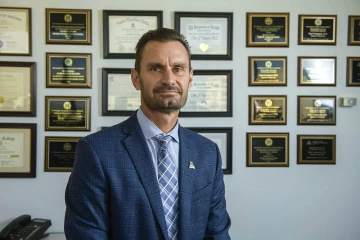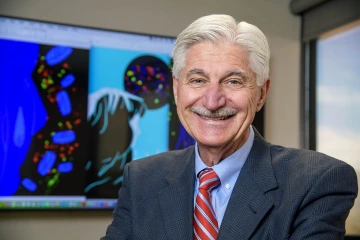Fostering Addiction Research Through Collaboration
A new center will advance addiction research through collaboration with faculty interested in studying substance use disorders.

“There's an undeniable link between opioids and their ability to modulate pain, but also their negative side effects in producing addiction,” said Frank Porreca, PhD, co-principal investigator on a $6.6 million grant to build the Center of Excellence for Addiction Studies. “We want to create new approaches to treat addiction.”
There are a record number of deaths from opioid overdoses being reported by the Centers for Disease Control and Prevention each year. From April 2020 to April 2021, an estimated 100,306 people died from drug overdoses, a 28% increase over the previous year. As the numbers continue to rise with no end in sight, novel approaches to battling the opioid epidemic are desperately needed. A new center at the University of Arizona Health Sciences is tackling the opioid crisis through the development of new collaborative research and support for faculty interested in pursuing research in addiction studies.

Todd Vanderah, PhD, one of two principal investigators on the Center of Excellence for Addiction Studies grant, researches the mechanisms and pharmacology of acute and chronic pain, as well as the body’s endogenous opioid and cannabinoid systems.
“This grant that will allow us to encourage those who want to study substance use disorders” said Dr. Vanderah, head and professor of pharmacology in the UArizona College of Medicine – Tucson and a member of the BIO5 Institute. “If a researcher has something they think might affect addiction, they will be able to explore collaboration with us to pursue these studies. Our goal is to work with investigators to develop ideas that will lead to solutions for the addiction crisis through peer-reviewed published studies and the fostering of new R01 grant proposals to the National Institute of Drug Abuse.”
Resources offered through the CEAS will be available to UArizona researchers as well as scientists at institutions throughout the country, including existing collaborations at Arizona State University, Northern Arizona University, the University of New Mexico and the Texas Tech University Health Sciences Center. Researchers at other institutions can utilize the novel models and advanced testing capabilities at the CEAS to develop new collaborations and studies, gather data necessary for publications and to pursue addiction-related funding.

Co-principal investigator Frank Porreca, PhD, studies the neurobiology of pain as a professor and associate department head in the College of Medicine – Tucson’s Department of Pharmacology.
The CEAS is designed to expand addiction research with a goal of developing therapies that can stem the opioid epidemic and impact other substance abuse disorders. It builds on UArizona Health Sciences’ existing strengths in pain and addiction research by offering that expertise to other scientists and sparking new collaborations.
“Over many years we've built up a strong group of people in the Department of Pharmacology who are researching the mechanisms of pain and chronic pain. There's an undeniable link between opioids and their ability to modulate pain, but also their negative side effects in producing addiction,” said Dr. Porreca, a professor in the Department of Pharmacology at the UArizona College of Medicine – Tucson. “We want to create new approaches to treat addiction. We are uniquely positioned to lead this effort since we have a large group of researchers and facilities that specialize in both areas of research.”
“That's the real desired outcome – to bring a lot of new, creative minds to solve the problems that are associated with addiction as a brain disorder.”Frank Porreca, PhD
The CEAS will focus on the detrimental response of brain circuits linked to addiction with three core area of emphasis: genetics, neuroanalytics and behavior.
The first core, genetic targeting of neural circuits, will allow researchers to employ cutting-edge genetic techniques to evaluate potential mechanisms relevant to addiction. The neuroanalytical core will provide researchers with advanced methods of measuring neurotransmitters through state-of-the-art detection methods. The behavioral core will allow researchers to explore questions relevant to addiction using behavioral tests that evaluate addictive processes including the influence of addictive drugs on cognitive function.
“When we bring these three components together – measuring transmitters and where they act, measuring cell-specific manipulations in brain circuits that can produce and influence behavior, and then measuring the behavior itself – it becomes powerful in putting together projects that can be designed to answer questions relevant to drug addiction and relapse,” Dr. Porreca said.
Additionally, a pilot research project will support exploratory projects to create new technology or approaches that could extend the capacity to do research in addiction sciences.
“The center will serve as a nexus for groups working on addiction research,” Dr. Vanderah said, adding that the CEAS also will promote increased diversity in addiction research by recruiting and training faculty and students from underrepresented populations in neuroscience and addiction science. “It’s not just us; it's serving a whole community of individuals.”

